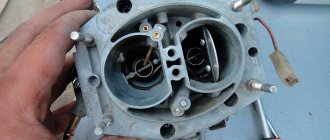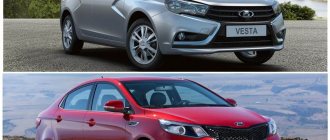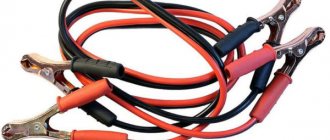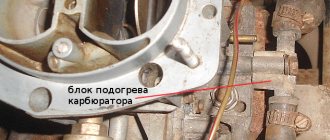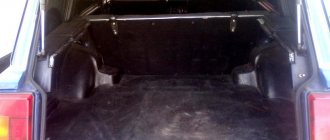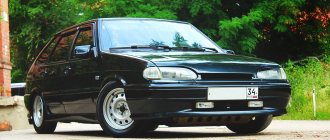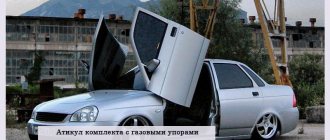For quite a long time, the domestic automaker AvtoVAZ has set its designers the task of creating a sports modification of the car, similar to the German GTI. Despite the fact that initially similar plans were made for the modification of the VAZ-2110 - the three-door hatchback 2113, in practice the result was a completely different sports version of the “ten”.
The cooperation with AvtoVAZ was very effective. At MIMS-96, a concept version of the VAZ-21106 GTI called “Yellow Shark” was presented. It was created specifically for homologation, which required the presence of a specific number of civilian versions of cars in the WRC group. Not to mention the fact that at that time in Russia there was a huge demand for such sports versions of familiar models. The VAZ-21106, modified in this way, was practically not inferior in technical characteristics to its German counterparts, which allowed the owners of such cars to enter into races with BMW and Mercedes at traffic lights.
Main differences
The sports version of the usual “ten” differed primarily in the installed power unit from an Opel petrol type with a displacement of 2.0. VAZ-21106, depending on the chosen configuration, had a power ranging from 136 to 150 horsepower - not the most ideal characteristics, but quite acceptable for this car, taking into account its weight. The transmission and power unit were supplied by the English branch of General Motors - Vauxhall.
In the VAZ-21106 GTI version, the 2.0-liter sixteen-valve engine had a power of 150 horsepower and allowed the car to accelerate to the first hundred in 9 seconds. The maximum speed was 200 km/h. The engine installed on the VAZ-21106 had its own design features - a separate oil cooler and a forged piston group.
Technical characteristics of VAZ 21106
• General data: number of places - 5; • curb weight - 1100 kg; • total weight - 1525 kg; • maximum speed - 205 km/h; • acceleration time from zero to 100 km/h - 9.5 s; • fuel consumption at 90, 120 km/h and in GC - 6.5; 8.3; 10.5 l/100 km; • fuel reserve - 60 l; • fuel - unleaded gasoline with an octane number of 95 (short-term use of gasoline with an octane number of 92 is allowed). Dimensions, mm
: length - 4242;
width - 1693; height - 1432; base - 2537; front/rear track - 1479/1448; ground clearance - 135. Engine
: Opel C20XE, gasoline, four-cylinder in-line, with distributed fuel injection, located transversely at the front;
• working volume - 2.0 l; • number of valves per cylinder - 4; • cylinder diameter and piston stroke - 86x86 mm; • compression ratio - 10.5; • power - 110 kW/150 l. With. at 6000 rpm; • maximum torque - 196 N.m at 4800 rpm. Transmission
: drive - front wheels;
• F18 gearbox - five-speed. • “Economical” option: I – 3.583; II - 1.870; III - 1.226; IV - 0.919; V - 0.744. • “Sports” version (maximum speed is achieved in fifth gear): I — 3.583; II - 2.143; III - 1.481; IV - 1.121; V - 0.892. • Main pair to choose from: 3,450; 3.571; 3.737. Suspension
: independent, front - MacPherson type, assembled on a subframe, • rear - with trailing arms.
Brakes
: hydraulic, with vacuum booster;
• front - ventilated disc, rear - drum. Steering
: rack and pinion with hydraulic booster.
Tire size
: 185/65R15, 195/60R15 or 205/55R15.
Car modifications
The VAZ-21106 was produced in various generations, differing both in exterior and technical equipment. The first version was a concept car shown at MIMS-96. The VAZ-21106 GTI 16V was equipped with a 2.0-liter engine from Opel with 150 horsepower, Koni shock absorbers, disc brakes and ZF power steering. As additional options, sports trim and air conditioning were offered. This modification was produced until 2000.
The second generation of the sports car was more budget-friendly: it was equipped with an ECOTEC engine, Torgmash shock absorbers and rear drum brakes. In this modification, the VAZ-21106 received an updated body design with massive wheel arches and an aerodynamic body kit. The second generation was discontinued in 2003.
The third generation looked almost nothing like the classic VAZ-2110. In terms of technical equipment, the model almost completely repeated the previous generation and was equipped with rear drum brakes, power steering from ZF, Acomi shock absorbers and a C20SEL engine.
The sports version of the VAZ-21106 was assembled until 2004, but you can also find cars produced much later on individual orders. The model was produced specifically for the traffic police, but due to design difficulties, its service life was short and its maintenance was unprofitable.
Technical Specifications VAZ 21106
Ten sports engines are mounted on a subframe, which is already a significant advantage in terms of reducing vibrations and increasing body rigidity. Initially, a c20xe engine was installed under the hood of the VAZ 21106 - this is the same famous, 150-horsepower unit with a torque of 198 N.M. It is noteworthy that from the factory this engine was equipped with forged pistons. To reach 100 km per hour, the driver of a VAZ 21106 with such an engine needed only 9.5 seconds, the maximum speed was 205 km.
Later, this engine was replaced by the c20se with a power of 136 hp, which is considered significantly less successful than the first unit. In both cases, a five-speed F18 gearbox was used. It is noteworthy that this ten gains maximum speed in 5th gear, and not in 4th gear, like many less powerful tens.
It is also worth adding that the 106th model is equipped with anti-roll bars not only at the front, but also at the rear.
Price VAZ 21106
Finding such a car on the secondary market today is very difficult. You can hardly expect to buy a VAZ 21106 in a live state for less than 250,000 rubles. The price of the VAZ 21106, which is significantly higher than the usual ten, is justified, because when driving they are different cars.
Of course, servicing such a car will be more expensive and perhaps it makes sense to find not the 106th model, but an Opel Vectra A with the same engine - c20xe, but here a lot depends on the region of your residence, there may not be a live example nearby and such a Vectra at all. Although in cities with a population of millions it is much easier to find a sports Vectra than a sports ten, most likely it will also cost less. But here it is - who likes what.
Everyone enjoys it in their own way, some like to ride off-road on a Niva, and some like to feel the speed, and from the category of second people, car enthusiasts who are passionate about tuning stand out, that is, not those who immediately had money for a good fast car, but those who Gradually, putting in a lot of effort, I made my car better and faster. It is precisely to such people who have tuned mainly the domestic auto industry that the VAZ 21106 may seem like a very interesting car, which even today is capable of leaving behind a two-liter Accord and a lot of other really worthy imported cars.
Wheels
The “Yellow Shark” was equipped with forged wheels made to special order. Despite this, small-scale versions of the VAZ-21106 were equipped with forged D16 wheels produced by. The rebranding of the wheel manufacturer (the company changed its name to SMK - Stupino Metallurgical Plant) was the reason that wheel rims began to be produced under a different index - D18 and were no longer installed on 21106.
Results
Overall, this car turned out to be quite successful. It has good technical characteristics, as well as dynamic and controllability characteristics. Today you can purchase this vehicle, but you need to understand that it will be quite difficult to maintain it. This is due to the unavailability of many parts. But it should also be noted that if there are problems with the motor, it will be quite easy to replace or repair it due to the fact that the engine was mass produced.
Unique modifications
One of the unique versions of the VAZ-21106 was a two-door coupe model. The first two copies were created with metal wings - in order to facilitate the removal of rough matrices from them for the production of similar parts from fiberglass in the future. The coupe series was limited: only 150 cars were produced.
For professional sports, two separate modifications of the VAZ-21106 were produced: special for rally 21107, with an integrated safety cage, and 21106 WTCC, the team of which took part in the 2008 FIA WTCC Championship.
Despite the fact that some versions of 21106 were intended specifically for sports, the model itself has taken part in such competitions since 1999: almost every year the car participated in circuit racing in the Russian RTCC series. In fact, the initial idea of the domestic concern AvtoVAZ was realized only towards the end of the assembly line production of the base VAZ-2110 model.
In a foreign style: how and when comfort and safety options appeared en masse on Ladas
Air conditioning, power steering, anti-lock brakes and airbags have long become common features of foreign cars, including representatives of the so-called budget segment. The Russian auto giant from Togliatti is not lagging behind - for about ten years now many models with a rook on a grille with climate control, airbags, and ABS. When were these previously unavailable options massively introduced on Ladas?
We have already talked about how air conditioning was even provided at the factory . on a VAZ-2108! Indeed, some export modifications of G8s in Tolyatti were equipped with kits produced by the Japanese company SANDEN. However, for a long time they remained a “thing in itself”, practically unknown to the domestic consumer, and even abroad Samara with air conditioning was rather exotic.
The airbag on Ladas also first appeared on the “chisel” - but not on the three-door model, but on the five-door Lada Baltic , which was produced for the European market in Finland in the mid-nineties - at the Valmet plant in the city of Uusikaupunki. The Baltika was equipped with an airbag steering wheel manufactured by Volkswagen AG - the same steering wheels, but with a different logo, were found on the VW Golf MKIII, VW Passat B4 and Skoda Felicia. In addition, air conditioning was also offered as an option on the Lada Baltic, but most of the cars were still not equipped with it.
with airbag
Lada Baltic was equipped with an airbag module manufactured by TRW
VAZ-2110: its thorny path
However, these pleasant “extras” were still not intra-VAZ developments, although power steering and microclimate systems began to be seriously studied in Togliatti back in the eighties.
While working on the “ten”, VAZ entered into a licensing agreement with ZF, which envisaged the creation of two types of steering mechanism - a conventional rack and pinion with a variable gear ratio and a version with a hydraulic booster.
Height adjustment of the steering column is another “foreign” innovation of the VAZ-2110
Alas, the introduction of power steering simultaneously with a conventional “rack” was prevented by the lack of funding and a “truncated license”, which was concluded only for the mechanism itself, while the pump, reservoir and the rest of the “piping” had to be purchased abroad.
The “Ten” initially relied on power steering developed by ZF. But this model received it already “at the end” of its conveyor life
That is why the Chevrolet Niva - or rather, the Tolyatti enterprise “Steering Systems”, created jointly with ZF, in addition to the mechanism for the “shnivy”, mastered the production of “tenth” power steering units, which were supplied to the VAZ conveyor.
On the “ten”, the designers decided to abandon the heater tap, at the same time using an automatic control system for ventilation and heating - the so-called SAUO, which could independently change the temperature in the cabin depending on the position of the controls. Of course, for the system to function as a full-fledged climate control system, this would require an air conditioner. Unfortunately, during work on the VAZ-2110, it remained not fully developed, and for financial reasons, installation with expensive imported components (compressor and radiator) would have increased the price of the car by at least $1,000, which was at that time neither the plant nor the mass Russian consumer can afford it. That is why air conditioning never appeared on mass production cars of this family, although in the pilot production of VAZ it was installed to order for non-standard modifications based on the “tens”.
The letter “A” on the VAZ-2110 heater regulator indicated the automatic operating mode of the ventilation and heating system! True, without air conditioning it was rather automated heating...
As part of the work on the “ten”, ABS tests were carried out, but they, like the rest of the “bells and whistles”, were fully implemented only on the following models - Kalina and Priora .
Potentially, the “ten” could have come from the factory not only with a hydraulic booster, but also with an air conditioner with ABS. Did not work out
However, it was the VAZ-2110 that became the first Lada for which all these systems were provided at the development stage. Alas, the birth of the “antelope” was difficult, long and difficult - it was such a time...
Kalina: EMUR on the assembly line!
Based on global trends, Kalina was immediately conceived to be equipped with power steering, which has long become commonplace even on small cars. When choosing between a hydraulic or electric drive, designers chose electromechanical power steering (EMPS) for several reasons. Firstly, its module is noticeably more compact and does not require “piping” with hoses, a pump and other hydraulic features. Secondly, the gain on the “electric” steering wheel can be set at the firmware level - that is, this provided greater opportunities for adjusting the information content of the steering. Thirdly, EMUR is simply cheaper to mass produce, easier to install and better suited for a relatively weak engine, since it practically does not load it at low speeds. Finally, the electric power steering “helps” the driver only when required, while traditional power steering operates as long as the engine is running.
Kalina “immediately” received EMUR, but airbags, air conditioning and ABS for this model had to wait several years
The electric booster of VAZ cars is noticeably more compact than the “hydraulics”
Unfortunately, despite the listed advantages of “electrics”, it was on Kalina that domestic motorists initially encountered a very unpleasant effect - in the event of a malfunction of the Makhachkala gear-type EMUR, the steering acquired a certain “independence”! During the trip, this was fraught with loss of control and even an accident. Therefore, a central type electric amplifier made in Kaluga or Dimitrovgrad turned out to be much more preferable, which subsequently began to be installed not only on Kalina, but also on Priora. It is interesting that the amplifier for Kalina was produced not only by the listed domestic suppliers, but also by the Korean company MANDO.
Several different amplifiers were installed at Kalina in Togliatti, which differed not only in their “production geography”, but also in their reliability
In 2008, a significant event occurred: Lada Kalina received an air conditioning unit from the Japanese company Panasonic as serial equipment! In addition, along with Priora, Kalina began to be equipped with airbags and ABS. Thus, in terms of equipment, the cars of the Volzhsky Automobile Plant not only caught up with the “old-fashioned” budget foreign cars like Nexia, but also surpassed them! After all, the hydraulic booster and the treasured “A/C” button, which was the subject of long-term envy of VAZ manufacturers, are good, but there were no ABS or airbags even in the top versions of the Uzbek Daewoo Nexia.
Initially, the ventilation and heating system of the VAZ-1118 had only a recirculation system
The easiest way to identify the presence of air conditioning in a first-generation Kalina is by the presence of a “snowflake” icon on the button near the driver
Over time, the first generation Kalina received two front airbags
Priora: “full stuffing” from the factory
When upgrading the “ten” to the Priora, the presence of a factory air conditioner was no longer even discussed - at least as an option for expensive trim levels. At the same time, even while working on the VAZ-2110, the designers encountered a problem - the standard radiator of the cooling system was not enough, and directly in front of it there was an air conditioner heat exchanger, which also worsened the airflow of the main radiator. That is why the design of the front optics on the Priora was changed, abandoning horizontally elongated light blocks in favor of “drop-shaped” headlights located at the edges of the front end.
At the time the Priora was launched on the market in Tolyatti, they were well aware that to compete with foreign cars, a version with air conditioning was simply necessary
Even at the stage of early prototypes, symbols appeared in the Priora instrument cluster indicating the presence of ABS and airbags “on board”
In May 2008, that is, a year after the start of serial production of the Priora, the first batch of cars equipped with air conditioning went on sale. It is interesting that for the Priora, “climates” with different designs immediately began to be produced by as many as two companies - the Russian-Korean Halla and the Japanese Panasonic.
Since Priora was launched into mass production after Kalina, many developments that, for one reason or another, once “didn’t go” to the top ten, went to Priora by analogy with Kalina. In particular, this is an electric power steering - but unlike the notorious Makhachkala product, they immediately began installing a gearless type EMUR on the “Seventy”, which is noticeably more stable in characteristics and more reliable in operation. But it was at Priora that the Kaluga EMUR (2172-3450008-02) somehow “distinguished itself”: isolated cases of failure of Avtoelectronics JSC products due to the use of electronic components of inadequate quality are known. It is interesting that on some cars of the Priora family, as well as on the VAZ-2110 of the last years of production, in Tolyatti they continued to install power steering, and only modifications without air conditioning were equipped with it, since together there are both “hydraulics” and “air conditioning” in the engine compartment of this model didn't get along. However, later enthusiasts, in non-factory conditions, combined power steering and air conditioning on the Priora, which required moving the power steering pump and other modifications.
On the Priora, the buyer could even choose the type of power steering! True, only if the air conditioning was not important to him
For the first time on a VAZ car, a driver's airbag, even in the basic configuration, appeared on the Priora.
Also, the Priora in the “Lux” configuration, along with air conditioning, received an airbag not only for the driver, but also for the passenger. During a factory crash test of a Priora with a pair of airbags, it turned out that in this configuration it even surpasses the fourth generation Volkswagen Golf in terms of points! Of course, at the same time, Priora was inferior to the “golfs” of the next generation, but. Let’s not forget that, at its core, the “seventy” still remained a modernized VAZ-2110. However, since 2013, in the “luxury”, side airbags have also been added to the front airbags - why not a “foreign car”?
Two Priora pillows are the norm in the modern automotive world
In October 2007, another important historical event occurred: many years after the start of work on ABS as standard equipment for Kalina and Priora cars, the ABS 8.1 anti-lock braking system from Bosch was finally introduced.
Operation and reviews
Due to the fact that serial production of the VAZ-21106 was limited, in practice the car causes a lot of trouble for its owner due to some design features. Among these unique features are a heating system of an original design and wiring that has nothing in common with other VAZ or Opel cars. For this reason, it is almost impossible to carry out computer diagnostics of the 106th model.
The VAZ-21106 suspension is classic, of an original design - with wishbones and a subframe. The remaining details are, in fact, a “hodgepodge”, due to which the maintenance of such a sports version of the regular 2110 results in a tidy sum for the car enthusiast.
Messages 17
1 Topic by Michael400 2015-10-01 22:59:17
- Michael400
- New member
- Inactive
- Registration: 2015-01-14
- Messages: 98 Thanks : 9
- Car: VAZ 21120
Topic: Opel C20XE engine in VAZ 2112
I was eager to install this engine, but there was very little information. If there are people who have done this, please respond. And the first question: if the engine of the 106 is installed on a subframe, will this subframe fit on mine without a bunch of modifications? Maybe the engine can be installed simply through the pillows?
2 Reply from kosmos 2015-10-01 23:10:42
- cosmos
- Blocked
- Inactive
- Registration: 2014-05-17
- Posts: 2,021 Thanks : 406
- Auto: 2111 - 1.5 -16v
Re: Opel C20XE engine in VAZ 2112
I was eager to install this engine, but there was very little information. If there are people who have done this, please respond. And the first question: if the engine of the 106 is installed on a subframe, will this subframe fit on mine without a bunch of modifications? Maybe the engine can be installed simply through the pillows?
To be honest, it’s not worth it, it’s a bad engine, with a bunch of problems that are more difficult and expensive to solve than VAZ ones, they even stopped installing it on our tenth family because of the problems.. And installing it will most likely require welding to overcook the fasteners, so that a welding machine is needed for everyone. and if with a subframe, then even more welding will be needed.
3 Reply from Michael400 2015-10-01 23:28:42
- Michael400
- New member
- Inactive
- Registration: 2015-01-14
- Messages: 98 Thanks : 9
- Car: VAZ 21120
Re: Opel C20XE engine in VAZ 2112
I was eager to install this engine, but there was very little information. If there are people who have done this, please respond. And the first question: if the engine of the 106 is installed on a subframe, will this subframe fit on mine without a bunch of modifications? Maybe the engine can be installed simply through the pillows?
To be honest, it’s not worth it, it’s a bad engine, with a bunch of problems that are more difficult and expensive to solve than VAZ ones, they even stopped installing it on our tenth family because of the problems.. And installing it will most likely require welding to overcook the fasteners, so that a welding machine is needed for everyone. and if with a subframe, then even more welding will be needed.
It’s just that my engine is coming to the end of its life and I have a great desire to install this particular one! The car should turn out to be vigorous with it and with the Opel gearbox, and of course the brakes will be improved, safety after all.
4 Reply from iliaBkmz 2015-10-02 00:04:11
- iliaBkmz
- Forum legend
- Inactive
- Registration: 2012-11-12
- Messages: 2,041 Thanks : 584
- Car: outlander and 2104
Re: Opel C20XE engine in VAZ 2112
+1 disgusting engine, which will be very problematic to install and almost impossible without experience in such work. IMHO it is better to install it from a Japanese cut.
5 Reply from kosmos 2015-10-02 00:05:16 (2015-10-02 00:06:30 edited by kosmos)
- cosmos
- Blocked
- Inactive
- Registration: 2014-05-17
- Posts: 2,021 Thanks : 406
- Auto: 2111 - 1.5 -16v
Re: Opel C20XE engine in VAZ 2112
Michael400 , to be honest, I also wanted to put it on once.. But! I was dissuaded, it’s too whimsical .. and no matter how much I haven’t seen it, people criticize it .. I apologize, of course, try it, otherwise I’ve been criticizing here)))) I think if you bother with replacing the engine, then install some proven one , personally, I trust the Japanese. And Opel has always been crappy, to be honest.. And the fact that the old engine is suitable for a bulkhead, you can easily rebuild it, and it will only cost 6.8 rubles, of course, if you do it yourself, but if honestly, there is nothing to do there. I am, of course, an experienced auto mechanic, but I choose our engines, they are cheap, not fussy, and any fool can fix them, rebuild them, etc., although I can also install them from a submarine. Briefly speaking! If you install an engine, no matter what, you will need welding anyway, and it’s better to choose a semi-automatic, weld the engine mount like two fingers on the asphalt, well, for me personally, of course. And I wish you good luck! Here's another topic for you about your engine! — https://xn--2111-43da1a8c.xn--p1ai/vybor... -2110.html
Source
Development of the model range
AvtoVAZ designers began to think about developing a sedan based on the VAZ 2108, 2109 series in the mid-80s. It was the development of this that led to the design split in Tolyatti, the consequences of which are still felt today. Instead of simply changing the contours of the rear part of the VAZ 2109 body and making a spacious trunk, the designers proposed almost a thousand different changes, including quite expensive ones. An electronic engine control and diagnostic system (on-board computer), a new galvanizing technology, power steering, etc. were provided. AvtoVAZ management, instead of closing the expensive project, decided to carry out work in two directions:
- complicated development of VAZ 2110;
- creation of a simplified version of the VAZ 21099.
Subsequently, both concepts coexisted in the design bureau and on the factory assembly line. The VAZ 2110 line developed into the 110 family and later into the Lada Priora, and the VAZ 21099 line became the basis of the Samara 2, Kalina and Kalina 2 family.
Which Opel engine is suitable for a VAZ
IMHO this is an Opel in the back of 2112 THEN an Opel in the back of 2114 is sharp
It's like playing a Blu-ray disc on a gramophone.
Nope. when I'm drunk I'm violent
_________________ you can have whatever beliefs you want as long as they do not disagree with ours.
I will leave the bliss of paradise for the poor; the poor in spirit must have a king and a god.
S20xe engine, shoots well. Stood on Vectra A, Kadett, Caliber. Yes, but you need rear disc brakes.
On dozens there was another 2 liter engine (136 hp) x20xev
S20xe engine, shoots well. Stood on Vectra A, Kadett, Caliber. Yes, but you need rear disc brakes.
On dozens there was another 2 liter engine (136 hp) x20xev
_________________ you can have whatever beliefs you want as long as they do not disagree with ours.
I will leave the bliss of paradise for the poor; the poor in spirit must have a king and a god.
Isn't it easier to buy an Opel?
S20xe engine, shoots well. Stood on Vectra A, Kadett, Caliber. Yes, but you need rear disc brakes.
On dozens there was another 2 liter engine (136 hp) x20xev
S20xe engine, shoots well. Stood on Vectra A, Kadett, Caliber. Yes, but you need rear disc brakes.
On dozens there was another 2 liter engine (136 hp) x20xev
_________________ you can have whatever beliefs you want as long as they do not disagree with ours.
I will leave the bliss of paradise for the poor; the poor in spirit must have a king and a god.
S20xe engine, shoots well. Stood on Vectra A, Kadett, Caliber. Yes, but you need rear disc brakes.
On dozens there was another 2 liter engine (136 hp) x20xev
Well, in the very first line I wrote s20xe as the first word
S20xe engine, shoots well. Stood on Vectra A, Kadett, Caliber. Yes, but you need rear disc brakes.
On dozens there was another 2 liter engine (136 hp) x20xev
Well, in the very first line I wrote s20xe as the first word
On dozens there was another 2 liter engine (136 hp) x20xev
_________________ you can have whatever beliefs you want as long as they do not disagree with ours.
I will leave the bliss of paradise for the poor; the poor in spirit must have a king and a god.
S20xe engine, shoots well. Stood on Vectra A, Kadett, Caliber. Yes, but you need rear disc brakes.
On dozens there was another 2 liter engine (136 hp) x20xev
Well, in the very first line I wrote s20xe as the first word
On dozens there was another 2 liter engine (136 hp) x20xev
0what do you think they shoved the Opel one in there? After all, it’s quite easy to remove 150 horsepower from the pelvis... or did they muddy it under the turbo?
_________________ you can have whatever beliefs you want as long as they do not disagree with ours.
I will leave the bliss of paradise for the poor; the poor in spirit must have a king and a god.
_________________ you can have whatever beliefs you want as long as they do not disagree with ours.
I will leave the bliss of paradise for the poor; the poor in spirit must have a king and a god.
Design
Despite the strong similarity to the Vesta sedan, the coupe shown in the renderings has a number of unique features that emphasize the sporty nature of the car. Moreover, as noted earlier, the difference between the two versions of the same model is not limited to a shortened body with two side doors.
The presented cross-coupe, like other cars of this class, has a sloping body, the roofline of which slopes gently towards the stern. This stylistic decision is not only due to the configuration features of such models, but is also intended to improve the aerodynamic performance of the body. As a result, it allows, with other parameters being equal, to improve acceleration dynamics and reduce fuel consumption.
At the same time, the front support pillars of the cross-coupe are placed at the same angle as those of the Vesta sedan. Accordingly, the dimensions of the windshield are the same for both models. The similarity between the cars can also be seen in the fact that the new product borrows a sloping hood with pronounced stamping stripes from the Vesta sedan. Otherwise, the front part of the cross-coupe’s body is designed in a style unique to the latest Lada models.
The presented new product has a radiator grille that stands out. It contains 2 horizontal plastic strips, on which the Lada brand badge is placed, and a fine mesh. On either side of it there are seemingly familiar head optics. At least its shape and dimensions follow the outline of the Lada Vesta headlights. But the new head optics contains several LED strips placed like a Christmas tree. The central part, or “trunk,” extends beyond the headlights and extends along the radiator grille to the Lada brand badge.
The X-shaped bars running from the bottom of the head optics have been switched from the standard Vesta to the new product. Also, the cross-coupe has a niche for mounting a license plate in the same place. But the side cutouts in the front bumper of the new product turned out to be larger. Their dimensions were apparently increased in order to expand the ventilation holes. This decision indirectly indicates that the new cross-coupe may receive a more powerful engine. This, in turn, confirms the assumption that the 2021-2022 Lada Vesta coupe will move to the CMF-B-LS modular platform.
Inside these cutouts, the designers placed 3 square lanterns. The bottom of the front bumper is partially covered by a metal plate, above which you can see a thin strip of air intake.
From the side, the new product presented looks more like a cross-version of the Vesta sedan. Both cars have increased ground clearance and a plastic body kit. At the same time, the new product is equipped with only two doors. The rear glazing of the Lada Vesta 2021-2022 coupe is located at a sharper angle than that of a standard sedan. This is due to the peculiarities of the body configuration. The rear support pillars smoothly flow into the trunk lid, which is complemented by a developed spoiler.
The rear optics of the cross-coupe are taken from the Vesta sedan. But the new product has LED strips running along the perimeter of the lights. The shape of the trunk lid, with the exception of the spoiler, and the rear bumper of the cross-coupe are also taken unchanged from the standard sedan.
Notes
- . “Behind the Wheel” (No. 10, October 2002). Date accessed: May 6, 2015.
- Vadim Kryuchkov.
. Behind the wheel (August 1, 2004). Date accessed: October 30, 2019. - Alexander ALESHIN.
.
Exchange + Auto
. VAZ (December 26, 2002). Access date: December 30, 2022. - ↑
- “Auto business” No. 8 (104), 1998 - Article “VAZ-21106, Yellow Shark from Russian automotive waters”
- “MAXI Tuning” No. 03, 2006 - P. 32.
- (English). fiaresultsandstatistics.motorsportstats.com
. FIA. Access date: October 30, 2022. - Mikhail Afanasyev.
(unavailable link).
autotest.pro
(September 11, 2015). Date accessed: February 27, 2022. - Vyacheslav Vasilenko.
. Behind the wheel (July 30, 2015). Access date: December 11, 2016. - S. Mishin.
(unavailable link). ZR (1998, no. 10). Date accessed: July 10, 2018. - . Behind the wheel (March 1, 2004). Date accessed: November 9, 2022.
- . Mail.ru (September 29, 2009). Date accessed: November 9, 2019.
Service
Maintenance typical for cars produced by AvtoVAZ. The main maintenance operations are changing the oil and oil filter. To change the lubricant, 3.2 liters of engine oil is required. In turn, 3.5 liters of lubricant fits into the engine.
It is recommended to fill in semi-synthetic motor oils marked 5W-30, 5W-40, 10W-40, 15W40.
The maintenance map looks like this:
TO-1: Oil change, oil filter replacement. Carry out after the first 1000-1500 km. This stage is also called the break-in stage, since the engine elements are grinding in.
TO-2: The second maintenance is carried out after 10,000 km. So, the engine oil and filter are changed again, as well as the air filter element. At this stage, the pressure on the engine is also measured and the valves are adjusted.
TO-3: At this stage, which is performed after 20,000 km, the standard procedure for changing the oil, replacing the fuel filter, as well as diagnosing all engine systems is carried out.
TO-4: The fourth maintenance is perhaps the simplest. After 30,000 km, only the oil and oil filter element are changed.
TO-5: The fifth maintenance is like a second wind for the engine. This time a lot of things are changing. So, let's look at which elements need to be replaced in the fifth maintenance:
- Change of oil.
- Replacing the oil filter.
- Replacing the air filter.
- Replacing the fuel filter element.
- The timing belt and roller are replaced.
- Alternator belt if necessary.
- Water pump.
- Valve cover gasket.
- Other items that need to be replaced.
- Valve adjustment, which adjusts the gas distribution mechanism.
Subsequent maintenance is carried out according to the 2-5 maintenance map for the corresponding mileage.
Geometric dimensions of openings
| For body 2111 | For body 2112 | For body 21123 |
| A – long diagonal of the rear side window frame – 780 mm | D - long diagonal of the rear side window frame - 710 mm | And – short diagonal of the front doorway – 1000 mm |
| B - short diagonal of the rear side window frame - 370 mm | E - short diagonal of the rear side window frame - 230 mm | K – long diagonal of the front doorway – 1500 mm |
| B – diagonal of the rear door opening – 1280 mm | F - diagonal of the rear door opening - 1320 mm | M - short diagonal of the rear side window frame - 720 mm |
| D – distance from the middle of the upper beam of the rear door opening to the middle of the lower beam of the opening – 925 mm | Z - distance from the middle of the upper beam of the rear door opening to the middle of the lower beam of the opening - 1050 mm | H - long diagonal of the rear side window frame - 1040 mm |
You can learn more about what the main body dimensions of the VAZ 2112 are from the table above and photo materials.
In addition, valuable information about methods for measuring geometric diagonals can be gleaned from other instructions presented on our website. To independently solve the problem of restoring parts of a VAZ 2112 car, you need to have the geometric dimensions of its body. In professional workshops, these parameters must be taken into account, and they are individual for each machine model. Violation of body geometry must be eliminated, since it significantly reduces the safety of driving such a car. From this article you can learn important information about the indicators on which high-quality repair of the VAZ 2112 body depends.
